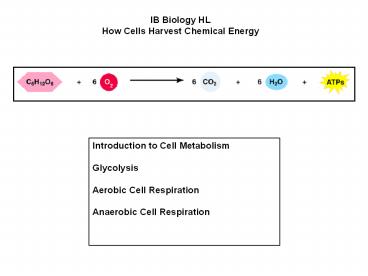IB Biology HL - PowerPoint PPT Presentation
1 / 32
Title:
IB Biology HL
Description:
IB Biology HL. How Cells Harvest Chemical Energy. Introduction to Cell ... Gasoline energy converted to movement. Burning gasoline. in an auto engine. 25 ... – PowerPoint PPT presentation
Number of Views:628
Avg rating:3.0/5.0
Title: IB Biology HL
1
IB Biology HL How Cells Harvest Chemical Energy
Introduction to Cell Metabolism Glycolysis Aerob
ic Cell Respiration Anaerobic Cell Respiration
2
Breathing and Cell Respiration are related
BREATHING
O2
CO2
Lungs
Muscle cells carrying out
CO2
O2
Bloodstream
CELLULAR RESPIRATION
Sugar O2 ? ATP CO2 H2O
3
Cellular Respiration uses oxygen and glucose to
produce Carbon dioxide, water, and ATP.
Glucose
Oxygen gas
Carbon dioxide
Water
Energy
4
How efficient is cell respiration?
Energy released from glucose banked in ATP
Energy released from glucose (as heat and light)
Gasoline energy converted to movement
100
About 40
25
Burning gasolinein an auto engine
Burning glucose in an experiment
Burning glucosein cellular respiration
5
Reduction and Oxidation
OILRIG Oxidation is losing electrons Reduction
is gaining electrons
Loss of hydrogen atoms
Energy
Glucose
Gain of hydrogen atoms
Glucose gives off energy as is is oxidized
6
Reduction and Oxidation OILRIG Gain
or loss of electrons is often in the form of
hydrogen. The hydrogen is then passed to a
coenzyme such as NAD
7
Reduction and Oxidation What are some common
co-enzymes? NAD and FAD
NAD 2 H ? NADH H
FAD 2 H ? FADH2
Remember that H 2 electrons and 2H
8
Reduction and Oxidation These co-enzymes are
very important for cell respiration because they
transfer high-energy electrons to electron
transport systems (ETS).
9
Reduction and Oxidation As the electrons move
from carrier to carrier, energy is released in
small quantities.
Electron transport system (ETS)
10
Generation of ATP There are two ways to
generate ATP Chemiosmosis Substrate-Level
Phosphorylation
11
Generation of ATP Chemiosmosis
Cells use the energy released by falling
electrons in the ETS to pump H ions across a
membrane Uses the enzyme ATP synthase.
12
Generation of ATP Chemiosmosis
13
Generation of ATP Substrate Level
Phosphorylation
Enzyme
ATP can also be made by transferring phosphate
groups from organic molecules to ADP
Adenosine
substrate
Adenosine
product
14
Generation of ATP Substrate Level
Phosphorylation
Enzyme
ATP can also be made by transferring phosphate
groups from organic molecules to ADP
Adenosine
substrate
Adenosine
product
15
General Outline
Glucose
Glycolysis
No Oxygen Anaerobic
Oxygen Aerobic
Pyruvic Acid
Transition Reaction
Fermentation
Krebs Cycle
ETS
36 ATP
16
Glycolysis Where? The cytosol What? Breaks
down glucose to pyruvic acid
17
Steps A fuelmolecule is
energized,using ATP.
Glucose
1
3
Step
Glycolysis
1
Glucose-6-phosphate
2
Fructose-6-phosphate
Energy In 2 ATP
3
Fructose-1,6-diphosphate
Step A six-carbonintermediate splits into
two three-carbon intermediates.
4
4
Glyceraldehyde-3-phosphate (G3P)
5
Step A redoxreaction generatesNADH.
5
1,3-Diphosphoglyceric acid(2 molecules)
6
Steps ATPand pyruvic acidare produced.
3-Phosphoglyceric acid(2 molecules)
6
9
Energy Out 4 ATP
7
2-Phosphoglyceric acid(2 molecules)
8
2-Phosphoglyceric acid(2 molecules)
NET 2 ATP
9
Pyruvic acid
(2 moleculesper glucose molecule)
18
General Outline
Glucose
Glycolysis
No Oxygen Anaerobic
Oxygen Aerobic
Pyruvic Acid
Transition Reaction
Fermentation
Krebs Cycle
ETS
36 ATP
19
General Outline of Aerobic Respiration
Glycolysis
Transition Reaction
Krebs Cycle
Electron Transport System
20
Transition Reaction
Each pyruvic acid molecule is broken down to
form CO2 and a two-carbon acetyl group, which
enters the Krebs cycle
Pyruvic Acid
Acetyl CoA
21
General Outline of Aerobic Respiration
Glycolysis
Transition Reaction
Krebs Cycle
Electron Transport System
22
Krebs Cycle Where? In the Mitochondria What?
Uses Acetyl Co-A to generate ATP, NADH, FADH2,
and CO2.
23
Krebs Cycle
24
Krebs Cycle
25
General Outline of Aerobic Respiration
Glycolysis
Krebs Cycle
Electron Transport System
26
Electron Transport System
Proteincomplex
Intermembranespace
Electroncarrier
Innermitochondrialmembrane
Electronflow
Mitochondrialmatrix
ELECTRON TRANSPORT CHAIN
ATP SYNTHASE
27
Electron Transport System
28
Electron Transport System
For each glucose molecule that enters cellular
respiration, chemiosmosis produces up to 38 ATP
molecules
29
Overview of Aerobic Respiration
30
General Outline
Glucose
Glycolysis
No Oxygen Anaerobic
Oxygen Aerobic
Pyruvic Acid
Transition Reaction
Fermentation
Krebs Cycle
ETS
36 ATP
31
Fermentation
Requires NADH generated by glycolysis.
Where do you suppose these reactions take place?
Yeast produce carbon dioxide and ethanol
Muscle cells produce lactic acid
Only a few ATP are produced per glucose
32
Fermentation































